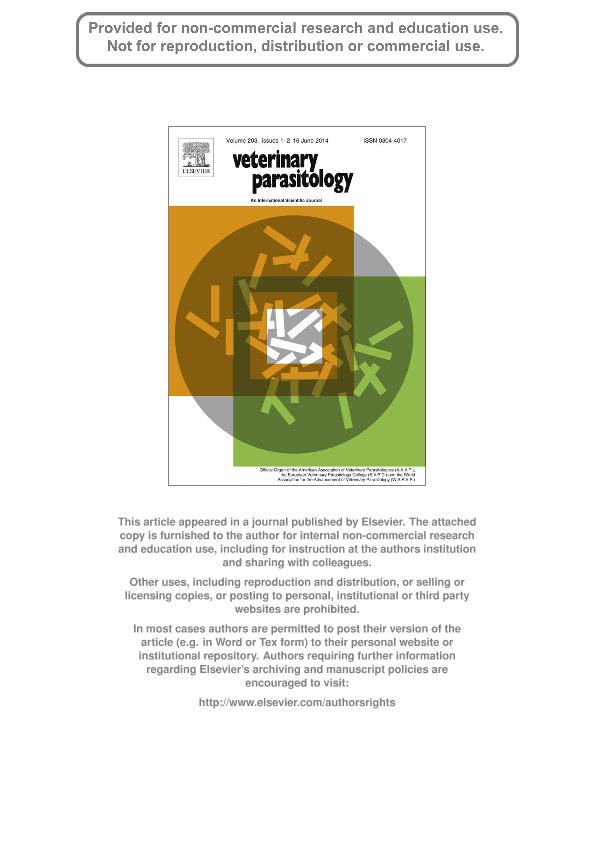Mostrar el registro sencillo del ítem
dc.contributor.author
Lifschitz, Adrian Luis

dc.contributor.author
Ballent, Mariana

dc.contributor.author
Virkel, Guillermo Leon

dc.contributor.author
Sallovitz, Juan Manuel

dc.contributor.author
Viviani, Paula

dc.contributor.author
Lanusse, Carlos Edmundo

dc.date.available
2018-01-16T21:36:19Z
dc.date.issued
2014-03
dc.identifier.citation
Virkel, Guillermo Leon; Sallovitz, Juan Manuel; Lanusse, Carlos Edmundo; Viviani, Paula; Ballent, Mariana; Lifschitz, Adrian Luis; et al.; Accumulation of monepantel and its sulphone derivative in tissues of nematode location in sheep: Pharmacokinetic support to its excellent nematodicidal activity; Elsevier Science; Veterinary Parasitology; 203; 1-2; 3-2014; 120-126
dc.identifier.issn
0304-4017
dc.identifier.uri
http://hdl.handle.net/11336/33554
dc.description.abstract
The amino-acetonitrile derivatives (AADs) are a new class of anthelmintic molecules active against a wide range of sheep gastrointestinal (GI) nematodes including those that are resistant to other anthelmintic families. The plasma disposition of monepantel (MNP) has been previously characterized in sheep. However, information on drug concentration profiles attained at tissues of parasite location is necessary to fully understand the pharmacological action of this novel compound. The current work aimed to study the relationship between the concentrations of MNP parent drug and its main metabolite monepantel sulphone (MNPSO2), measured in the bloodstream and in different GI tissues of parasite location in sheep. Twenty two (22) uninfected healthy Romney Marsh lambs received MNP (Zolvix®, Novartis Animal Health) orally administered at 2.5 mg/kg. Blood samples were collected from six animals between 0 and 14 days post-treatment to characterize the drug/metabolite plasma disposition kinetics. Additionally, 16 lambs were sacrificed at 8, 24, 48 and 96 h post-administration to assess the drug concentrations in the GI fluid contents and tissues. MNP and MNPSO2 concentrations were determined by HPLC. MNP parent compound was rapidly oxidized into MNPSO2. MNP systemic availability was significantly lower than that observed for MNPSO2. The peak plasma concentrations were 15.1 (MNP) and 61.4 ng/ml (MNPSO2). The MNPSO2 to MNP plasma concentration profile ratio (values expressed in AUC) reached a value of 12. Markedly higher concentrations of MNP and MNPSO2 were measured in both abomasal and duodenal fluid contents, and mucosal tissues compared to those recovered from the bloodstream. A great MNP availability was measured in the abomasal content with concentration values ranging between 2000 and 4000 ng/g during the first 48 h post-treatment. Interestingly, the metabolite MNPSO2 was also recovered in abomasal content but its concentrations were significantly lower compared to MNP. The parent drug and its sulphone metabolite were detected in the different segments of the sheep intestine. MNPSO2 concentrations in the different intestine sections sampled were significantly higher compared to those measured in the abomasum. Although MNP is metabolized to MNPSO2 in the liver, the large concentrations of both anthelmintically active molecules recovered during the first 48 h post-treatment from the abomasum and small intestine may greatly contribute to the well-established pharmacological activity of MNP against GI nematodes.
dc.format
application/pdf
dc.language.iso
eng
dc.publisher
Elsevier Science

dc.rights
info:eu-repo/semantics/openAccess
dc.rights.uri
https://creativecommons.org/licenses/by-nc-nd/2.5/ar/
dc.subject
Monepantel
dc.subject
Gastrointestinal Tissues
dc.subject
Pharmacokinetics
dc.subject
Sheep
dc.subject.classification
Otras Ciencias Veterinarias

dc.subject.classification
Ciencias Veterinarias

dc.subject.classification
CIENCIAS AGRÍCOLAS

dc.title
Accumulation of monepantel and its sulphone derivative in tissues of nematode location in sheep: Pharmacokinetic support to its excellent nematodicidal activity
dc.type
info:eu-repo/semantics/article
dc.type
info:ar-repo/semantics/artículo
dc.type
info:eu-repo/semantics/publishedVersion
dc.date.updated
2018-01-16T18:48:18Z
dc.journal.volume
203
dc.journal.number
1-2
dc.journal.pagination
120-126
dc.journal.pais
Países Bajos

dc.journal.ciudad
Amsterdam
dc.description.fil
Fil: Lifschitz, Adrian Luis. Consejo Nacional de Investigaciones Científicas y Técnicas. Centro Científico Tecnológico Conicet - Tandil. Centro de Investigación Veterinaria de Tandil. Universidad Nacional del Centro de la Provincia de Buenos Aires. Centro de Investigación Veterinaria de Tandil. Provincia de Buenos Aires. Gobernación. Comision de Investigaciones Científicas. Centro de Investigación Veterinaria de Tandil; Argentina
dc.description.fil
Fil: Ballent, Mariana. Consejo Nacional de Investigaciones Científicas y Técnicas. Centro Científico Tecnológico Conicet - Tandil. Centro de Investigación Veterinaria de Tandil. Universidad Nacional del Centro de la Provincia de Buenos Aires. Centro de Investigación Veterinaria de Tandil. Provincia de Buenos Aires. Gobernación. Comision de Investigaciones Científicas. Centro de Investigación Veterinaria de Tandil; Argentina
dc.description.fil
Fil: Virkel, Guillermo Leon. Consejo Nacional de Investigaciones Científicas y Técnicas. Centro Científico Tecnológico Conicet - Tandil. Centro de Investigación Veterinaria de Tandil. Universidad Nacional del Centro de la Provincia de Buenos Aires. Centro de Investigación Veterinaria de Tandil. Provincia de Buenos Aires. Gobernación. Comision de Investigaciones Científicas. Centro de Investigación Veterinaria de Tandil; Argentina
dc.description.fil
Fil: Sallovitz, Juan Manuel. Consejo Nacional de Investigaciones Científicas y Técnicas. Centro Científico Tecnológico Conicet - Tandil. Centro de Investigación Veterinaria de Tandil. Universidad Nacional del Centro de la Provincia de Buenos Aires. Centro de Investigación Veterinaria de Tandil. Provincia de Buenos Aires. Gobernación. Comision de Investigaciones Científicas. Centro de Investigación Veterinaria de Tandil; Argentina
dc.description.fil
Fil: Viviani, Paula. Consejo Nacional de Investigaciones Científicas y Técnicas. Centro Científico Tecnológico Conicet - Tandil. Centro de Investigación Veterinaria de Tandil. Universidad Nacional del Centro de la Provincia de Buenos Aires. Centro de Investigación Veterinaria de Tandil. Provincia de Buenos Aires. Gobernación. Comision de Investigaciones Científicas. Centro de Investigación Veterinaria de Tandil; Argentina
dc.description.fil
Fil: Lanusse, Carlos Edmundo. Consejo Nacional de Investigaciones Científicas y Técnicas. Centro Científico Tecnológico Conicet - Tandil. Centro de Investigación Veterinaria de Tandil. Universidad Nacional del Centro de la Provincia de Buenos Aires. Centro de Investigación Veterinaria de Tandil. Provincia de Buenos Aires. Gobernación. Comision de Investigaciones Científicas. Centro de Investigación Veterinaria de Tandil; Argentina
dc.journal.title
Veterinary Parasitology

dc.relation.alternativeid
info:eu-repo/semantics/altIdentifier/doi/http://dx.doi.org/10.1016/j.vetpar.2014.02.049
dc.relation.alternativeid
info:eu-repo/semantics/altIdentifier/url/http://www.sciencedirect.com/science/article/pii/S030440171400137X
Archivos asociados
